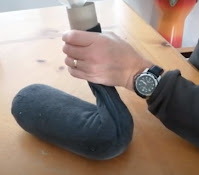A dehumidifier aka damp trap is an apparatus that removes atmospheric humidity. It becomes useful when moisture can degrade or even destroy products sensitive to it (moisture). This post will discuss the wet method. Another or dry method (image below) is discussed in a separate post.
 |
| Wet method |
You will need:
- a desiccant. Ones already discussed in the DIY movement and relatively easy to find include those in the list immediately below. See list of desiccants. The CaCl2 is the overall favorite for several reasons that include the fact that it is environmentally friendly and, unlike options like the silica gel, is not limited by a maximum absorption capacity. The matter related to the absorption capacity is especially important when tending to the dehumidifier is not an available option, as when freighting goods over an extended period.
- Calcium Chloride / CaCl2 (from hardware or home improvement stores)
- A container for the desiccant. Options include the following. In each case, the container should 1) have at least one hole that is sufficiently small to retain the desiccant while allowing water to drip through and 2) fit securely over another container while leaving air space between the 2 (as a catchment to collect trapped water as illustrated above by the blue water in the diagram).
- A bucket.
- The funnel shaped top of a bottle, like a Coca Cola bottle.
- A catchment reservoir. Options include the bottom of a bottle whose top has been removed as the desiccant container or another similar container, like a (second) bucket.
- (Optional). A utility knife, pair of scissors and or marker (to cut a straight liine through the bottle). Keep the marker's point or utility stable by anchoring it on top of several books to the height where you wish to cut the bottle. Pivot the bottle on a single axis, like its cap, while allowing the side of the bottle to keep contact with the marker or knife.
- Disposal. Pour the CaCl2 condensation water waste only in places where you do not want plants to grow for at least several months.
- Location with lingering humidity. Place the DIY dehumidifier in any space that does not experience movement. In other words, avoid door ways because they allow movement of air which prevents much moisture to settle. Instead, place the DIY dehumidifier in closed spaces like cupboards, closed small rooms or enclosed basements.
CONTENT RELATED TO HOW TO MAKE A DIY DEHUMIDIFER
- Learn about the dry method
 |
| Dry Method |
- A desiccant is a substance that absorbs atmospheric humidity. List of desiccants.


No comments:
Post a Comment